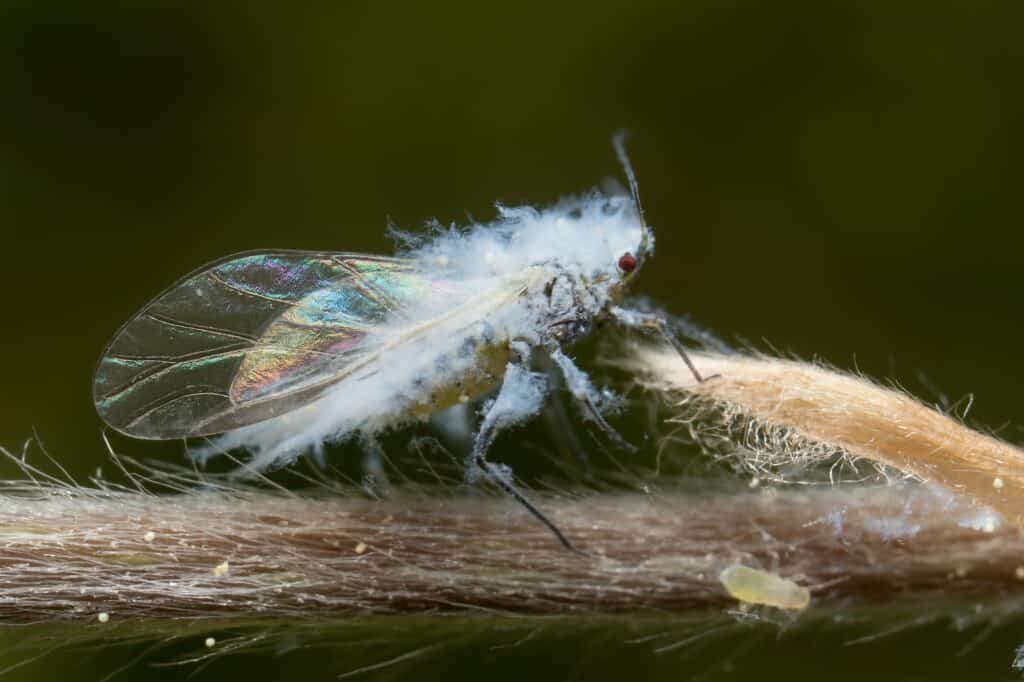Woolly Aphids
Eriosoma lanigerum
Another name for these fuzzy insects is "boogie-woogie aphids" because of their habit of lifting their posteriors and pulsing them in synchronized motions when threatened.
Advertisement
Woolly Aphids Scientific Classification
- Kingdom
- Animalia
- Phylum
- Arthropoda
- Class
- Insecta
- Order
- Hemiptera
- Family
- Aphididae
- Genus
- Eriosoma
- Scientific Name
- Eriosoma lanigerum
Read our Complete Guide to Classification of Animals.
Woolly Aphids Conservation Status
Woolly Aphids Facts
- Name Of Young
- Larvae
- Group Behavior
- Infestation
- Fun Fact
- Another name for these fuzzy insects is "boogie-woogie aphids" because of their habit of lifting their posteriors and pulsing them in synchronized motions when threatened.
- Most Distinctive Feature
- White and fuzzy waxy material covering their bodies.
- Other Name(s)
- Boogie-woogie aphids
- Habitat
- Vegetable gardens, orchards, and ornamental flower gardens
- Predators
- Ladybugs, Hoverfly larvae, Lacewing larvae
- Diet
- Omnivore
- Lifestyle
- Diurnal
- Favorite Food
- Sap
- Common Name
- Woolly aphid
- Location
- Every continent except Antarctica
View all of the Woolly Aphids images!
Aphids are sap-sucking pests that barely measure over a quarter of an inch long. However, the woolly aphids are unique because they are green or blue, but they appear white and fuzzy because of the waxy material covering their bodies.
These insects use two hosts: the first for overwintering and laying their eggs in the spring and the second for feeding in the summer. Woolly aphids feed in large groups, generally on foliage, twigs, buds, bark, branches, and roots.
The damage they cause is easily recognized, but the twisted and curled leaves, slow plant growth, yellow foliage, the growth of galls or cankers on the limbs or roots of trees.
Woolly Aphid Scientific Name
The woolly aphid’s scientific name is Eriosoma lanigerum, and they belong to the order Hemiptera. This order includes:
- Shieldbugs
- Plant bugs
- Bed bugs
- Pond skaters
- Cicadas
- Water bugs
- Aphids
- Scale insects
Members of Hemiptera are referred to as true bugs and consist of a diverse group of insects with about 75,000 species worldwide.
There are 1,700 species in the British Isles alone! While these species differ significantly in size and appearance, they have a few common traits, like penetrating mouthparts used to suck the juice from plants and animals.
In addition, their mouth parts are protected by a beak (rostrum) which is stored beneath the body when they aren’t using it.
Woolly aphids are members of the family Aphididae. This family consists of 4000 species, and while these species are sap-sucking pests in low to moderate numbers, they are not very harmful to garden plants.
Aphids cause leaves to lose their green coloring because they feed on the cell contents, decreasing the green leaf area essential for photosynthesis. They typically feed in clusters on new plant growth.
However, they generally go unnoticed unless there is a substantial infestation that will cause a reduction in the plant’s vigor. Other symptoms include abnormal growth and the yellowing of leaves.
Woolly Aphid Appearance

Covered in a white, fluffy, wax coating, woolly aphids are generally 0.12 inches in length.
©Tomas Vacek/Shutterstock.com
Woolly aphids are generally 0.12 inches in length, with pear-shaped bodies covered in a white, fluffy, waxy coating. They are serious apple pests but also target elm, mountain ash, hawthorn, alder, pyracantha, and serviceberry trees.
Their bodies are blueish-green in color, and their waxy coating looks like white fluff. They are generally found feeding on the base of new shoots, roots, trunk wounds, and branches.
Unfortunately, their feeding causes galls to form, which leads to cracked and swollen areas on the tree. These cracks are perfect for rot and canker to enter the branches. This is why an aphid infestation is so serious and why they are also referred to as American blight aphids.
Woolly Aphid Behavior
Woolly aphids are primarily active during the day, making them diurnal insects. Another name for these fuzzy insects is “boogie-woogie aphids” because of their habit of lifting their posteriors and pulsing them in synchronized motions when threatened.
Woolly Aphid Habitat
Woolly aphids are very adaptable and can be found on various plants and trees. However, they are primarily drawn to vegetable gardens, orchards, and ornamental flower gardens. They usually hide beneath tree bark during winter but will emerge once the temperature heats up during spring.
Woolly Aphid Diet
Woolly aphids feed on sap by inserting their needle-like mouth parts into the plant tissue. They will feed on a tree’s roots, leaves, bark, and buds. The sap they ingest produces a sticky substance, referred to as honeydew, resulting in sooty mold on the plant.
Woolly Aphid Predators and Threats
Woolly aphids are preyed upon by various creatures like:
- Ladybugs
- Hoverfly larvae
- Lacewing larvae
The only threat to aphids is humans, who kill them because they are pests.
Woolly Aphid Life Cycle
Woolly aphids typically have two host plants, one for overwintering and laying eggs and the other for feeding on during the summer. The eggs they lay during the winter hatch during spring.
The larvae are born as parthenogenic females, which means they can give birth without male fertilization and produce hundreds of offspring quickly. This means that population numbers can increase rapidly during the summer.
However, after one or two generations on their winter host, they produce winged females who migrate to the summer host. The females will remain there for the rest of the summer, producing several generations of woolly aphids.
When fall arrives, a different generation of winged females fly back to their winter host and give birth to males and females that will mate. Once mating is over, the female will either deposit one giant egg or multiple little eggs into the bark of the winter host and, shortly after, dies.
Woolly Aphid Prevention
There are many insecticides on the market that will take care of a woolly aphid infestation. However, several natural methods work just as well, if not better.
One of the best ways to eliminate an aphid infestation is by introducing natural predators like ladybugs, hoverflies, and lacewings. In addition, using Neem oil or natural insecticidal soap will also work.
If there are any damaged foliage or branches, they should be cut down and removed. However, the easiest way to rid your plants of these aphids is by taking a hose and spraying the infested area with water, which should remove them.
Insects Similar to the Woolly Aphid
There are a few insects that are very similar to the woolly aphid; they include:
Jassid
Jassids are often referred to as leafhoppers and are members of the Cicadellidae family. Adults are typically green or yellow. However, some species vary in color from blue to red to white.
These insects are approximately 1 inch in length and shaped like wedges. Jassids have two sets of wings, and their mouthparts are called stylets.
The stylets help them with the sucking motion they use to collect sap. Their antennas have 3 to 10 segments, depending on the species. In addition, they have 3 segments, the head, thorax, and abdomen.
Thrip
Thrips are more detrimental to plants than aphids because they spread quicker and are not as selective when it comes to feeding.
They are winged insects that move from plant to plant in the wind and eat foliage by using their needle-like appendage to puncture the plant tissue. They are hard to see, making it tough to determine whether there is an infestation. However, thrips leave behind a silver discoloration at the root of the infestation.
They have slender bodies and come in various colors, ranging from yellow to brown to black. However, their silvery wings make them look like shiny gray flecks on plants. Unlike aphids, they will fly or jump off the plants if you bring an object too close.
Mealybugs
Mealybugs are much slower than aphids and occur on every section of the plant, including the roots. However, they are usually found on nodes and considered common pests of houseplants like succulents.
If there are small dots resembling white cotton on plants, it is the first sign of a mealybug infestation. However, this cotton-like substance is not the mealybug but the trail they leave behind.
They are very small insects with yellow coloring, but their size makes them really hard to see, and the trail they leave behind is one of the most obvious ways to identify them. However, whiteflies also leave behind a similar substance. But, it’s easier to tell these two insects apart because you can see whiteflies moving around.
Up Next
View all 108 animals that start with WWoolly Aphids FAQs (Frequently Asked Questions)
How do you get rid of woolly aphids?
One of the best ways to eliminate an aphid infestation is by introducing natural predators like ladybugs, hoverflies, and lacewings. In addition, using Neem oil or natural insecticidal soap will also work.
How do you control woolly apple aphids?
Insecticides include Beleaf, Diazinon Closer, Admire Pro, and Movento. However, they only work for above-ground infestations. Unfortunately, no insecticides can control root infestations on bearing apple trees.
How long do woolly aphids last?
The average lifespan of an aphid is approximately one month.
Thank you for reading! Have some feedback for us? Contact the AZ Animals editorial team.
Sources
- Gardening Know How, Available here: https://www.gardeningknowhow.com/plant-problems/pests/insects/woolly-aphid-control.htm
- The Spruce, Available here: https://www.thespruce.com/woolly-aphids-prevention-5124343
- Wikipedia, Available here: https://en.wikipedia.org/wiki/Eriosoma_lanigerum#Distribution

















